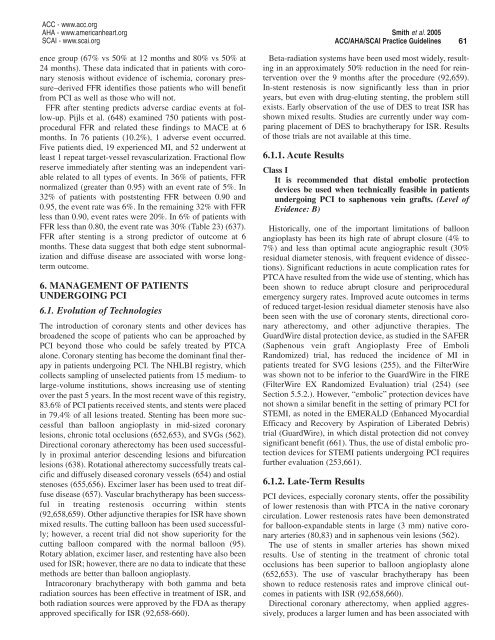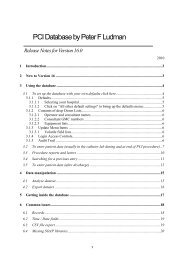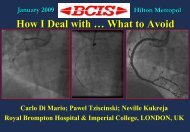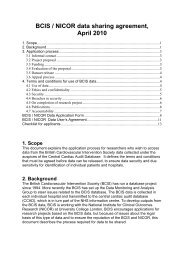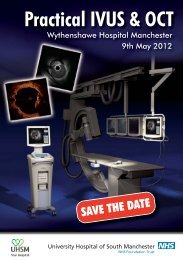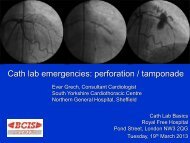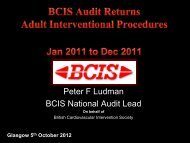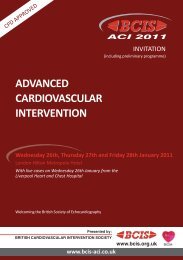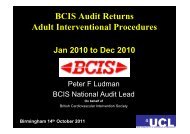Recommendations
ACC/AHA/SCAI PCI Guidelines - British Cardiovascular Intervention ...
ACC/AHA/SCAI PCI Guidelines - British Cardiovascular Intervention ...
- No tags were found...
You also want an ePaper? Increase the reach of your titles
YUMPU automatically turns print PDFs into web optimized ePapers that Google loves.
ACC - www.acc.org<br />
AHA - www.americanheart.org<br />
SCAI - www.scai.org<br />
Smith et al. 2005<br />
ACC/AHA/SCAI Practice Guidelines<br />
61<br />
ence group (67% vs 50% at 12 months and 80% vs 50% at<br />
24 months). These data indicated that in patients with coronary<br />
stenosis without evidence of ischemia, coronary pressure–derived<br />
FFR identifies those patients who will benefit<br />
from PCI as well as those who will not.<br />
FFR after stenting predicts adverse cardiac events at follow-up.<br />
Pijls et al. (648) examined 750 patients with postprocedural<br />
FFR and related these findings to MACE at 6<br />
months. In 76 patients (10.2%), 1 adverse event occurred.<br />
Five patients died, 19 experienced MI, and 52 underwent at<br />
least 1 repeat target-vessel revascularization. Fractional flow<br />
reserve immediately after stenting was an independent variable<br />
related to all types of events. In 36% of patients, FFR<br />
normalized (greater than 0.95) with an event rate of 5%. In<br />
32% of patients with poststenting FFR between 0.90 and<br />
0.95, the event rate was 6%. In the remaining 32% with FFR<br />
less than 0.90, event rates were 20%. In 6% of patients with<br />
FFR less than 0.80, the event rate was 30% (Table 23) (637).<br />
FFR after stenting is a strong predictor of outcome at 6<br />
months. These data suggest that both edge stent subnormalization<br />
and diffuse disease are associated with worse longterm<br />
outcome.<br />
6. MANAGEMENT OF PATIENTS<br />
UNDERGOING PCI<br />
6.1. Evolution of Technologies<br />
The introduction of coronary stents and other devices has<br />
broadened the scope of patients who can be approached by<br />
PCI beyond those who could be safely treated by PTCA<br />
alone. Coronary stenting has become the dominant final therapy<br />
in patients undergoing PCI. The NHLBI registry, which<br />
collects sampling of unselected patients from 15 medium- to<br />
large-volume institutions, shows increasing use of stenting<br />
over the past 5 years. In the most recent wave of this registry,<br />
83.6% of PCI patients received stents, and stents were placed<br />
in 79.4% of all lesions treated. Stenting has been more successful<br />
than balloon angioplasty in mid-sized coronary<br />
lesions, chronic total occlusions (652,653), and SVGs (562).<br />
Directional coronary atherectomy has been used successfully<br />
in proximal anterior descending lesions and bifurcation<br />
lesions (638). Rotational atherectomy successfully treats calcific<br />
and diffusely diseased coronary vessels (654) and ostial<br />
stenoses (655,656). Excimer laser has been used to treat diffuse<br />
disease (657). Vascular brachytherapy has been successful<br />
in treating restenosis occurring within stents<br />
(92,658,659). Other adjunctive therapies for ISR have shown<br />
mixed results. The cutting balloon has been used successfully;<br />
however, a recent trial did not show superiority for the<br />
cutting balloon compared with the normal balloon (95).<br />
Rotary ablation, excimer laser, and restenting have also been<br />
used for ISR; however, there are no data to indicate that these<br />
methods are better than balloon angioplasty.<br />
Intracoronary brachytherapy with both gamma and beta<br />
radiation sources has been effective in treatment of ISR, and<br />
both radiation sources were approved by the FDA as therapy<br />
approved specifically for ISR (92,658-660).<br />
Beta-radiation systems have been used most widely, resulting<br />
in an approximately 50% reduction in the need for reintervention<br />
over the 9 months after the procedure (92,659).<br />
In-stent restenosis is now significantly less than in prior<br />
years, but even with drug-eluting stenting, the problem still<br />
exists. Early observation of the use of DES to treat ISR has<br />
shown mixed results. Studies are currently under way comparing<br />
placement of DES to brachytherapy for ISR. Results<br />
of those trials are not available at this time.<br />
6.1.1. Acute Results<br />
Class I<br />
It is recommended that distal embolic protection<br />
devices be used when technically feasible in patients<br />
undergoing PCI to saphenous vein grafts. (Level of<br />
Evidence: B)<br />
Historically, one of the important limitations of balloon<br />
angioplasty has been its high rate of abrupt closure (4% to<br />
7%) and less than optimal acute angiographic result (30%<br />
residual diameter stenosis, with frequent evidence of dissections).<br />
Significant reductions in acute complication rates for<br />
PTCA have resulted from the wide use of stenting, which has<br />
been shown to reduce abrupt closure and periprocedural<br />
emergency surgery rates. Improved acute outcomes in terms<br />
of reduced target-lesion residual diameter stenosis have also<br />
been seen with the use of coronary stents, directional coronary<br />
atherectomy, and other adjunctive therapies. The<br />
GuardWire distal protection device, as studied in the SAFER<br />
(Saphenous vein graft Angioplasty Free of Emboli<br />
Randomized) trial, has reduced the incidence of MI in<br />
patients treated for SVG lesions (255), and the FilterWire<br />
was shown not to be inferior to the GuardWire in the FIRE<br />
(FilterWire EX Randomized Evaluation) trial (254) (see<br />
Section 5.5.2.). However, “embolic” protection devices have<br />
not shown a similar benefit in the setting of primary PCI for<br />
STEMI, as noted in the EMERALD (Enhanced Myocardial<br />
Efficacy and Recovery by Aspiration of Liberated Debris)<br />
trial (GuardWire), in which distal protection did not convey<br />
significant benefit (661). Thus, the use of distal embolic protection<br />
devices for STEMI patients undergoing PCI requires<br />
further evaluation (253,661).<br />
6.1.2. Late-Term Results<br />
PCI devices, especially coronary stents, offer the possibility<br />
of lower restenosis than with PTCA in the native coronary<br />
circulation. Lower restenosis rates have been demonstrated<br />
for balloon-expandable stents in large (3 mm) native coronary<br />
arteries (80,83) and in saphenous vein lesions (562).<br />
The use of stents in smaller arteries has shown mixed<br />
results. Use of stenting in the treatment of chronic total<br />
occlusions has been superior to balloon angioplasty alone<br />
(652,653). The use of vascular brachytherapy has been<br />
shown to reduce restenosis rates and improve clinical outcomes<br />
in patients with ISR (92,658,660).<br />
Directional coronary atherectomy, when applied aggressively,<br />
produces a larger lumen and has been associated with


